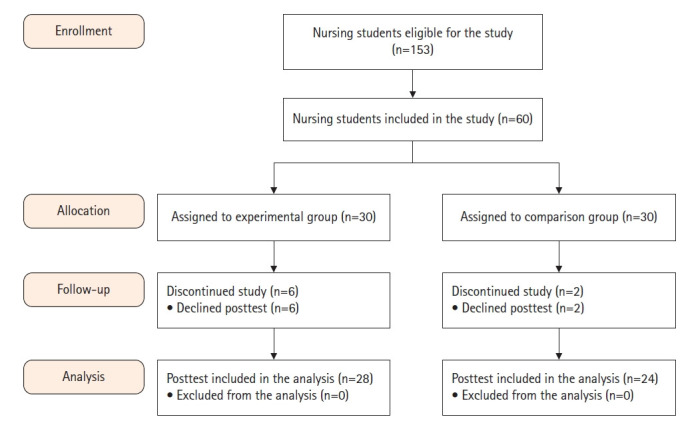虚拟现实模拟与基于问题的学习相结合对护生批判性思维能力、问题解决能力和自我效能感的影响:一项非随机试验。
IF 1
Q3 NURSING
Korean Journal of Women Health Nursing
Pub Date : 2023-09-01
Epub Date: 2023-09-26
DOI:10.4069/kjwhn.2023.09.12
引用次数: 0
摘要
目的:本研究分析了基于虚拟现实模拟的问题学习对护理生在引产妇女护理中的批判性思维能力、解决问题能力和自我效能感的影响。方法:采用非等效对照组的前测和后测设计。研究参与者包括52名护理专业学生(实验组24名,对照组28名)。实验组在第一周参加了基于问题的学习(PBL)课程,然后使用虚拟现实模拟进行自主学习。在第二周,进行了关于引产的紧急护理和药物管理的讲座。对照组在第一周参加PBL,第二周参加讲座。该研究于2023年4月17日至5月19日进行。使用卡方检验、Fisher精确检验、方差分析、,结果:两组在问题解决能力方面前后差异具有统计学意义(t=-5.47,P结论:采用虚拟现实模拟的PBL教育是一种有效的教学方式。尽管采用了方便抽样,但采用虚拟现实的PBL教学可以作为一种提高护生解决问题能力和自我效能的教育策略。本文章由计算机程序翻译,如有差异,请以英文原文为准。


Effects of a virtual reality simulation integrated with problem-based learning on nursing students' critical thinking ability, problem solving ability, and self-efficacy: a non-randomized trial.
PURPOSE
This study analyzed the effects of virtual reality simulation-based problem-based learning on nursing students' critical thinking ability, problem-solving ability, and self-efficacy in the nursing care of women undergoing induction of labor.
METHODS
A nonequivalent control group pretest and posttest design was employed. The study participants included 52 nursing students (24 in the experimental group and 28 in the control group). The experimental group took a problem-based learning (PBL) class in the first week, and then engaged in self-directed learning using virtual reality simulation. In the second week, lectures about emergency nursing care for induction of labor and drug administration were given. The control group participated in PBL in the first week and lectures in the second week. The study was conducted from April 17 to May 19, 2023. Data were analyzed using the chi-square test, Fisher exact test, analysis of variance, and the independent t-test.
RESULTS
Before-and-after differences between the two groups were statistically significant in problem solving ability (t=-5.47, p<.001) and self-efficacy (t=-5.87, p<.001). Critical thinking ability did not show a statistically significant difference between the two groups. The score for satisfaction with the virtual reality simulation program was 3.64±5.88 out of 5 in the experimental group.
CONCLUSION
PBL education using a virtual reality simulation was found to be an effective way of teaching. Although convenience sampling was used, PBL education using virtual reality can be used as an educational strategy to enhance nursing students' problem-solving ability and self-efficacy.
求助全文
通过发布文献求助,成功后即可免费获取论文全文。
去求助
来源期刊

Korean Journal of Women Health Nursing
Nursing-Maternity and Midwifery
CiteScore
1.50
自引率
33.30%
发文量
28
审稿时长
8 weeks
 求助内容:
求助内容: 应助结果提醒方式:
应助结果提醒方式:


